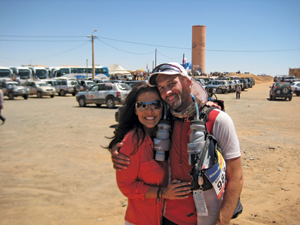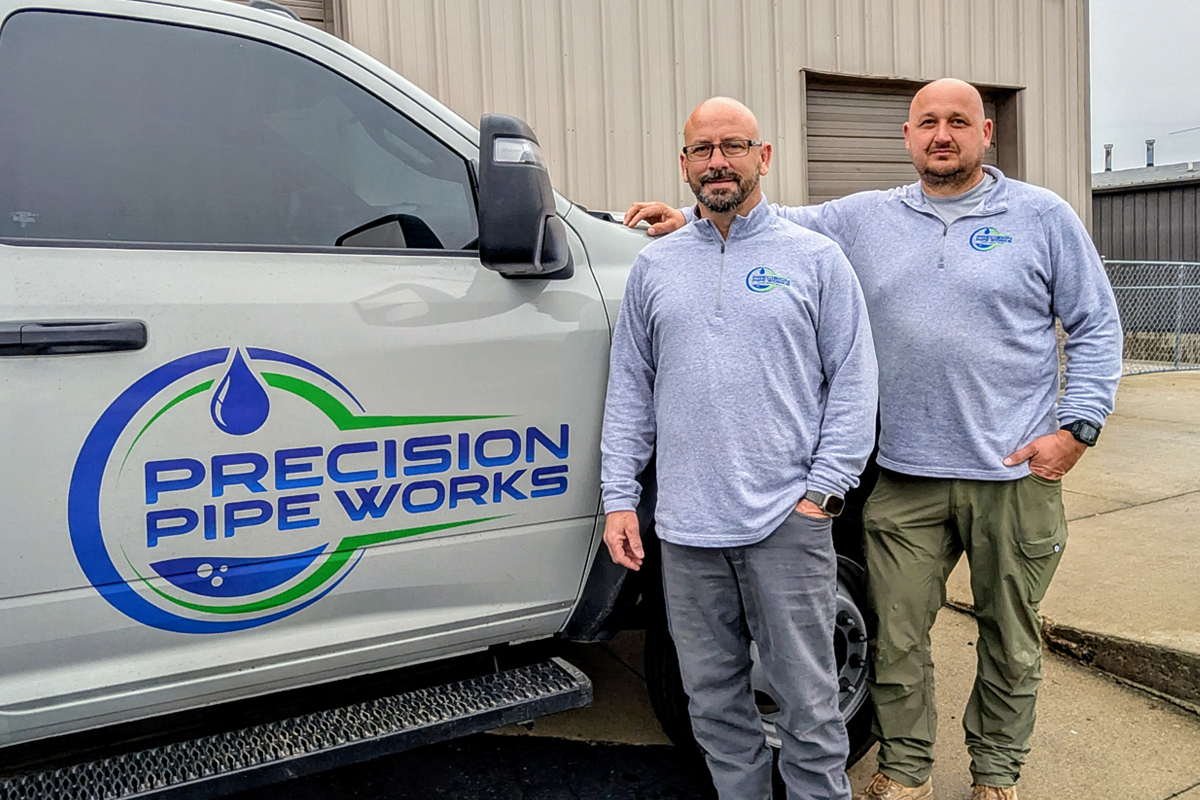Sahara Desert or Bust!
July 12, 2012
 John Milligan sets goals and challenges that push him to be a stronger person and to live life without regret — a credo he encourages others to follow as they navigate through their lives.
John Milligan sets goals and challenges that push him to be a stronger person and to live life without regret — a credo he encourages others to follow as they navigate through their lives.He loves the physical and emotional highs that running brings to his life, finding insight into who he is and how strong he is. His latest running challenge may top all his other races past and future.
Milligan recently completed (April 8-14) the 27th annual Sultan Marathon des Sables (MdS) — a grueling, six-stage, 251-km (156-mile) ultra-marathon through the Sahara Desert in Morocco in which participants run the equivalent of six regular marathons over seven days. Sounds crazy, yes? But for those who choose to take on this incredible challenge, well, they think it’s crazy, too.
“It’s called The Toughest Footrace on Earth… The point of the race is to test the limits of human endurance,” says Milligan, who is Vermeer’s AXIS program team leader. And that’s exactly what he did: test his limits on physical, mental and emotional levels.
“I did not understand how emotionally draining this race would be,” he says. “I experienced pain that I didn’t know existed. I did not know levels of pain like that could actually exist.”
Milligan, 41, is an avid marathoner, who prides himself on setting goals to push himself. In 2010, he set a goal of running a marathon in all 50 states by his 50th birthday (currently he’s run in 20 states). He saw this ultra-marathon as another challenge to take on. He first learned of the race in 2011 while traveling in the United Kingdom, piquing his interest. “I saw a documentary on Discovery U.K. on a British Olympian who had done the race a few years ago. It intrigued me because I thought, ‘Who is crazy enough to do that?’ And it just stuck with me.”
Milligan researched the event, learning more about it and eventually connected with the North American representative for the race, Dreamchasers Outdoor Adventures, Driggs, Idaho.
“The thing that captured my attention with MdS is that it’s known in the ultra-running community as the toughest footrace on earth. So I thought, ‘Why not?’ If it’s the toughest race on earth then I would like my name attached to it and take on something very few people have done. At the end of your life, you can look at what you’ve accomplished or you can sit back and wish that you had done this or that. I figured at 41, if I don’t do this now, I may never be able to do it.”
 The Marathon des Sables is not an event that is well publicized in North America but is considered hugely popular in the United Kingdom and France, which hold 600 to 650 of the 1,000 race slots. Organizers only allot so many for each country so it’s not unheard of to sit on a waiting list for a few years before getting your shot at the race. The North American group had 57 spots open to it in 2012 and Milligan was lucky enough to secure one of them.
The Marathon des Sables is not an event that is well publicized in North America but is considered hugely popular in the United Kingdom and France, which hold 600 to 650 of the 1,000 race slots. Organizers only allot so many for each country so it’s not unheard of to sit on a waiting list for a few years before getting your shot at the race. The North American group had 57 spots open to it in 2012 and Milligan was lucky enough to secure one of them.Training Schedule
Milligan began training for MdS in August 2011, which is not the same as training for a marathon — something Milligan says he can do in his sleep. For MdS runners, they train for the distance, harsh ground conditions and temperatures (which can be well over 120 F each day), but also for carrying everything they need on their backs. The backpack holds their food, sleeping bag and survival gear for seven days. Water was distributed at checkpoints throughout the race in 1.5-liter bottles. At the start of the race, the backpack can weigh up to 33lbs, per race rules.
“It’s one thing to train for a marathon,” Milligan says. “It’s another to train for back to back to back to back to back marathons. This is a self-sufficiency race. I basically went to work, ran, ate, slept and repeated.”
In January, Milligan picked up a marathon in Ohio that was run on an oval track, where he could test himself running with the full backpack. His typical running schedule involved two to three 20-mile runs Mondays through Thursdays, then a 10-mile recovery run on Fridays and then a 30- to 40-mile run on the weekends. He also ran his first ultra-marathon (50 miles) in Texas. He also upped his calorie intake to 4,000 a day, calculating that he would burn 3,500 calories a day running.
 “I ate a lot. It’s actually hard to eat 4,000 calories a day and eat healthy,” Milligan says. “It’s almost impossible. I was eating all the time. My guys would come in my office and say, ‘Are you eating again?’ and I tell them, ‘No, I’m still eating.’”
“I ate a lot. It’s actually hard to eat 4,000 calories a day and eat healthy,” Milligan says. “It’s almost impossible. I was eating all the time. My guys would come in my office and say, ‘Are you eating again?’ and I tell them, ‘No, I’m still eating.’”Desert Casualty
Milligan set what may be considered an ambitious goal of wanting to finish in the Top 10 percent, based on his personal racing history and that he finished 13th out of 259 finishers in the ultra-marathon during training. He fell short of the Top 10 percent, finishing 264th out of the 795 runners who finished the race. His race ended much differently than he had hoped due to injuries he sustained.
After the second day, his feet delaminated and the skin let loose on the balls and heels of his feet, resulting in excruciating pain and later, infection. His feet also sustained deep bruising. He met with one of the race doctors for treatment and got taped up; Milligan thought the doctor might pull him out of the race once she examined him. “She told me that it would hurt less if I cut [my feet] off,” Milligan relates, telling her he wanted to continue the race so she taped his feet up.
He continued on, completing the fourth stage that required him to run 81.5 km over a 34-hour period and having him draw on all the strength he had physically, mentally and emotionally to run through the pain. “I thought back to a quote my fiancée Kim sent me before the race started. It said: The miracle is not that I finished. The miracle is that I had the courage to start… I told myself that I just need to get to the starting line [for Stage 4] and figure it out from there. For the next 15 hours I just focused on each step again, again and again. The pain was so intense and I went to some really dark places during that run.”
But he made it through, focusing on the many e-mails he received (race officials distributed them each night at the bivouac), encouraging him. “From an emotional standpoint, this was the toughest thing I’ve ever done and will do. So many people believed in me so I couldn’t quit,” Milligan says.
 And he’s glad he didn’t. Though he is still recovering from the race, what he gained from it about himself more than distances the pain he endured. “The pain I experienced is one aspect. They say the desert finds your weakness and exploits it. It definitely humbled me and that’s not a bad thing to have happen. I used to think I was strong enough to do everything on my own but I found out that’s not true. If I didn’t have certain people to lean on, people e-mailing me and [fellow runners], I don’t think I would have finished. And that is humbling.”
And he’s glad he didn’t. Though he is still recovering from the race, what he gained from it about himself more than distances the pain he endured. “The pain I experienced is one aspect. They say the desert finds your weakness and exploits it. It definitely humbled me and that’s not a bad thing to have happen. I used to think I was strong enough to do everything on my own but I found out that’s not true. If I didn’t have certain people to lean on, people e-mailing me and [fellow runners], I don’t think I would have finished. And that is humbling.”Milligan says everyone needs to find something to challenge them to find out who they are and what they can endure. That being said, would he try again at the Marathon des Sables? “The short answer is no,” he says emphatically. “Unless I could be guaranteed that this wouldn’t happen to my feet again, I have no need to reach those levels of pain again.”
Sharon M. Bueno is managing editor of Trenchless Technology.
Tags: Vermeer




